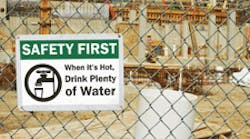Living in Arizona is like an endless summer. But if you're repairing city streets or utilities while wearing a hard hat, protective clothing and steel-toe boots, that's no summer vacation.
The heat in the Southwest is extreme and can be relentless. Unless you take the proper precautions, work-related heat stress and heat exhaustion are inevitable.
"Heat is dangerous, especially here in Arizona. We do everything we can to protect our work force on projects. Every employer should heed the message," said Jim Kuliesch of Alliance of Construction Trades.
While heat stress is serious, heat stroke can be deadly, with symptoms including dry, hot skin with no sweating; convulsions; severe vomiting; and even unconsciousness. That's when you've got to call 9-1-1 at once for help. In the meantime, move the worker to a cool, shaded area, loosen or remove heavy clothing, provide cool drinking water and mist the person.
"Unfortunately, most people think they have had enough to drink when they actually haven't, thus the heat stress symptoms – headaches, dizziness, lightheadedness, weakness – they experience," said Sharon Roman of Regulatory Compliance Consultants. "So, signs and labels remind employees to drink plenty of fluids."
Warning Signs
Any location in which there is the potential for heat stress should have warning signs. Signs should be posted wherever employees gather or pass through on the way to work. These include near time clocks, tool rooms, break areas, lunch areas and on vehicles used for transportation.
"Signage, in the form of posters on the job site, can serve as a reminder to employees about staying hydrated and bringing spare clothing to the job," explained Steve Hollenbach, project safety manager at McCarthy Building Companies Inc.
Leaving warning signs posted even when there is no danger from heat stress can lead to them becoming "invisible." At construction sites, which are temporary by their very nature, signs and labels should reflect current conditions.
"Out in Phoenix where triple digit temperatures rule, we have signs that read 'When it's hot, drink plenty of water and eat lightly,'" said Jim Latto of DBA Construction. "The copy – in both Spanish and English – runs alongside a picture of a man sweating in the desert sun. We conduct daily safety meetings and hydration is an issue we talk about quite often."
Consider some of the following tips for signs and messages designed to protect workers from heat stress:
· Post facts about heat stress such as, "Did you know men sweat more than women and are more susceptible to heat related illness?" at water stations and on bulletin boards – anywhere employees can see them frequently.
· Bilingual heat stress signs are necessary at sites that employ workers who speak other languages. Better yet, use pictures or drawings to make your statement in the simplest way possible.
· For agricultural workers who are advised to take rest breaks during harvest season, signs may need to adhere to trees, telephone poles or on the front of tents.
· A great place for heat stress signage is at the entrance to a mine. Workers can be advised to bring their own water bottles and a change of clothing before entering the mine.
Preventing Heat Stress
Familiarize yourself with the symptoms of heat-related illnesses. These might include:
· Weakness or giddiness
· Nausea
· Normal or slightly higher body temperature
· Pale, clammy skin (sometimes flushed)
· Mental confusion
· Delirium
· Body temperature of 106 degrees F or higher
· Hot, dry skin, usually red or bluish color
· Prickly heat, which may occur in hot and humid environments where sweat can't evaporate easily, causes rashes with small pink or red bumps and itching
· Loss of consciousness or fainting
Preventative measures include:
· Monitor yourself and coworkers.
· Block direct sun or other heat sources.
· Use cooling fans or air-conditioning.
· Rest regularly.
· Drink plenty of water.
· Wear lightweight, light colored, loose-fitting clothes.
· Eat light meals.
· Avoid alcohol.
· A change of clothing – especially socks or a fresh t-shirt – can provide a welcome break and help you feel refreshed.
· Adding too much ice to water or a sports drink could make an overheated worker feel sick.
· If you're not accustomed to the heat, move around instead of standing still to reduce the likelihood of fainting.
Finally, remember that while heat stress is most often a risk during hot summer weather, this isn't always the case.
"Heat stress is not limited to the outdoors. It can actually be hotter indoors in factories and enclosed places with heat-producing equipment," explained Roman.
Whether you work in the Southwest or in Alaska, during the long days of summer or in a warm warehouse year-round, follow the signs that point away from heat stress.
Jack Rubinger of Portland, Ore., is an industrial copywriter for Graphic Products Inc. and DuraLabel.com. He has more than 20 years of experience writing for safety, industrial and trade media.
